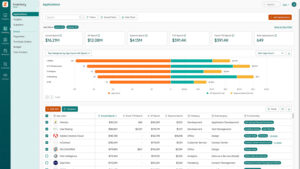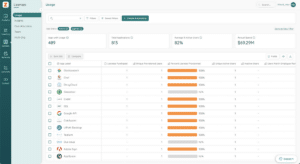
How to Build a Savings Pipeline for SaaS Renewals
Table of Contents ToggleWhat Is a SaaS Savings Pipeline?Why Managing SaaS...
Back
Back
Search for Keywords...
Blog

Table of Contents
How do you gain SaaS value for your Procurement team and maximize your tech investments? Let’s start with Procurement’s role.
By establishing Procurement as a central support team, they can focus on maximizing the value of your SaaS applications. Additionally, that support is enhanced by collaborating with business units and teams to effectively manage their subscription-based software.
When combined with SaaS visibility and management, a Procurement roadshow focused on SaaS can enable departments and teams to identify the unique challenges they face with SaaS tools.
Goals for a Procurement SaaS roadshow:
Identifying SaaS applications and their related cots throughout the organization is a critical first step. As SaaS tool usage expands and grows, almost anyone can now be a software buyer, including employees.
SaaS has become ubiquitous in most organizations because it’s easy to purchase, implement, and scale. And frequently, software vendors who use product-led growth models specifically market to end-users (aka departments, teams, and employees)—not IT or Procurement teams.
These factors and tactics can lead to the explosive growth of shadow IT— digital tools and technologies deployed in the organization without IT oversight or supervision.
No matter how large your organization is, discovering the current inventory of all SaaS and identifying ownership is the first step towards building new governance and controls. Zylo recommends using financial transactions as the source of truth for uncovering all software spending.
Once the initial discovery process is underway, gaps in SaaS spend data will become apparent. For example, according to Zylo data more than 50% of SaaS purchase transactions are not accurately attributed as software, which underscores how difficult it is to even identify shadow IT when present and the need for additional discovery.
For many organizations, a SaaS discovery process represents the first attempt at holistically identifying sources of software acquisition.
Don’t let good information go to waste. Preserve and maintain all discovery details in a system of record or collaborative record-keeping tool.
It’s possible to create a system of record using a spreadsheet, but because spreadsheet-driven record-keeping relies on manual curation – a lengthy process for large organizations – information becomes outdated quickly.
Zylo’s SaaS Management platform creates a continually updated and refreshed system of record that procurement, IT, and LOB teams can use as the source of truth for all SaaS-related actions and decision-making.

After identifying all applications within use in the organization and adding key information where needed, the next step to optimizing a SaaS portfolio is to contain costs and reduce wasted spend.
This is where the Procurement roadshow format can have the most impact. In most cases, each respective business unit will maintain its own “slice” of the overall application inventory pie. Now, with the centralized information produced by the discovery process, Procurement teams can help each business unit—and the organization overall—save money.
Recognizing cost containment opportunities for SaaS inventory management typically focuses on consolidating duplicate applications, eliminating functional overlaps, or transitioning applications into more favorable terms via enterprise agreements.
For many Procurement teams, obtaining maximum value from SaaS applications frequently takes a higher priority than cost containment or reduction measures.
This is especially true for Procurement teams managing large SaaS deployments of company-wide “backbone” solutions such as Salesforce, Workday, or G-Suite. Their primary goal is to get as much value out of these solutions as possible. To do so, Procurement and stakeholders must measure the utilization of their SaaS tools.
Zylo’s SaaS management tool empowers teams to uncover SaaS application utilization data such as last login, license count, and other activity indicators through integrations. Many applications (but not all), make this information available via direct queries or data exports as well.

With utilization measured, Procurement can drive new value for SaaS in three ways:
While establishing a system of record and demonstrating how business units can decrease costs and increase value via roadshows, Procurement builds collaborative processes that reinforce the shared goal of managing SaaS in the organization effectively and efficiently.
A regular cadence that involves reporting the results of utilization measurement and planning for upcoming renewals helps continue the conversation.
After answering the primary questions related to making the cloud software portfolio more effective, an essential goal for Procurement teams is defining the software acquisition, lifecycle management, and off-boarding process. In many organizations, this is accomplished by:
Few teams are as uniquely positioned as Procurement to deliver increased value and efficacy for the deployment of SaaS tools within an organization.
By using a Procurement roadshow to discover each team’s current SaaS portfolio, enable them to measure and manage their SaaS tools for increased effectiveness, and promote policies that contribute to a system of governance, the organization’s overall approach to SaaS management improves.
Ready to drive more SaaS value for your Procurement team? Learn more about Zylo or request a demo to see how SaaS management maximizes subscription software investments.

Table of Contents ToggleWhat Is a SaaS Savings Pipeline?Why Managing SaaS...

Table of Contents ToggleWhat FinOps Means in the Modern Cloud EnvironmentWhy...

Table of Contents ToggleStep 1: Create SaaS Value for Procurement with...

Table of Contents ToggleStep 1: Create SaaS Value for Procurement with...
| Cookie | Duration | Description |
|---|---|---|
| cookielawinfo-checkbox-analytics | 11 months | This cookie is set by GDPR Cookie Consent plugin. The cookie is used to store the user consent for the cookies in the category "Analytics". |
| cookielawinfo-checkbox-functional | 11 months | The cookie is set by GDPR cookie consent to record the user consent for the cookies in the category "Functional". |
| cookielawinfo-checkbox-necessary | 11 months | This cookie is set by GDPR Cookie Consent plugin. The cookies is used to store the user consent for the cookies in the category "Necessary". |
| cookielawinfo-checkbox-others | 11 months | This cookie is set by GDPR Cookie Consent plugin. The cookie is used to store the user consent for the cookies in the category "Other. |
| cookielawinfo-checkbox-performance | 11 months | This cookie is set by GDPR Cookie Consent plugin. The cookie is used to store the user consent for the cookies in the category "Performance". |
| viewed_cookie_policy | 11 months | The cookie is set by the GDPR Cookie Consent plugin and is used to store whether or not user has consented to the use of cookies. It does not store any personal data. |
